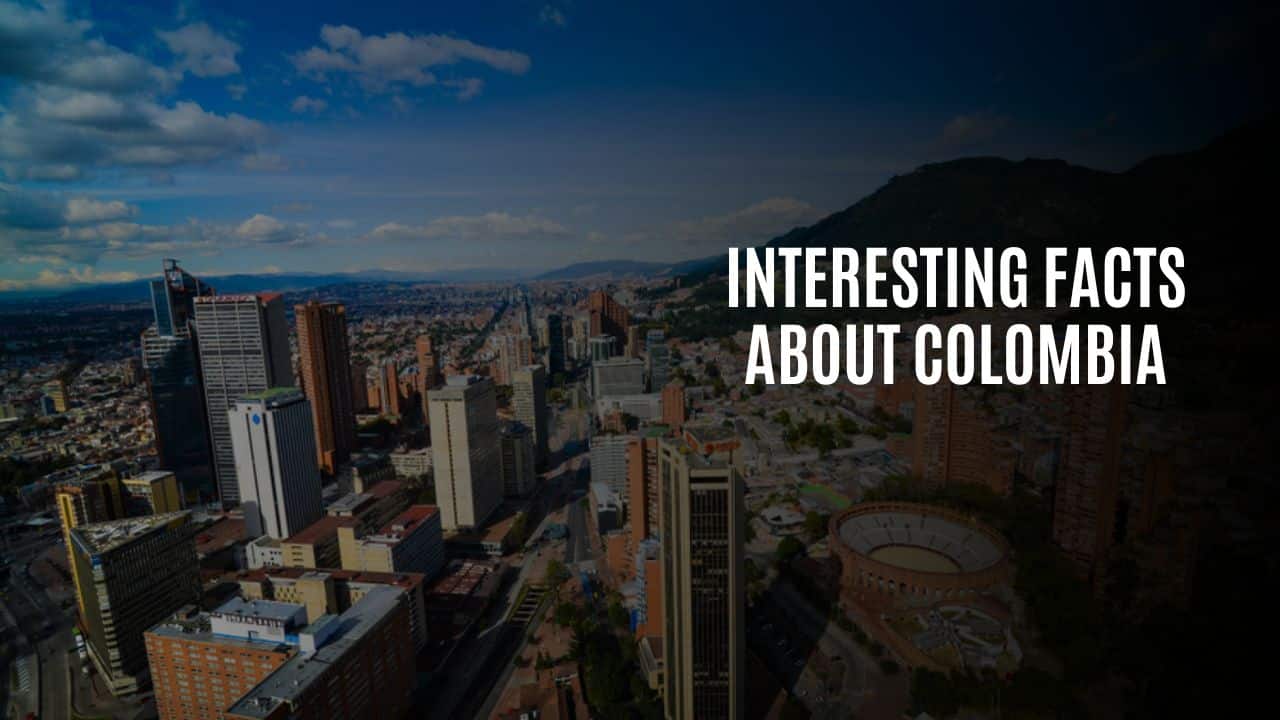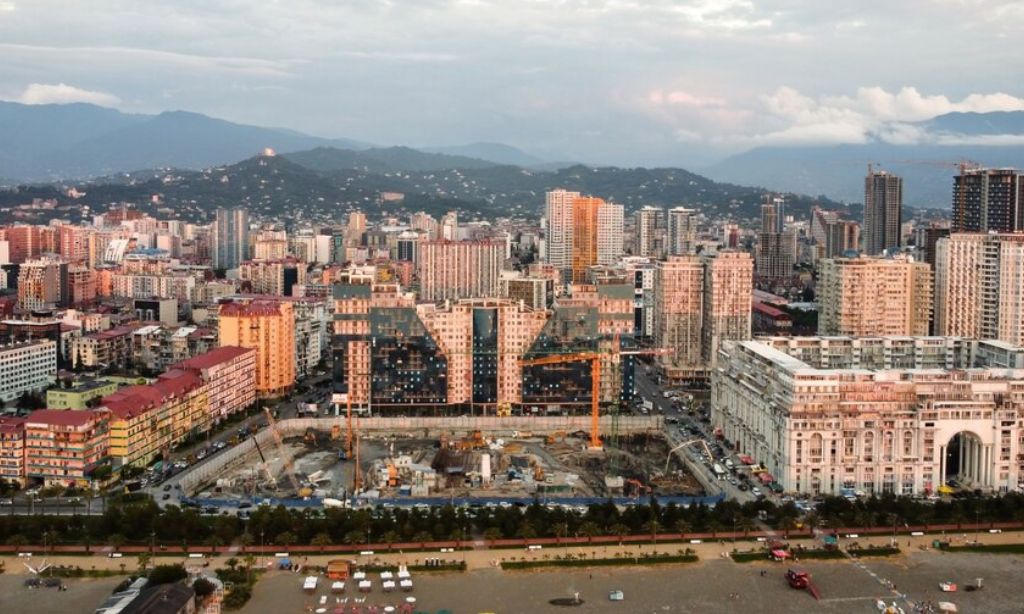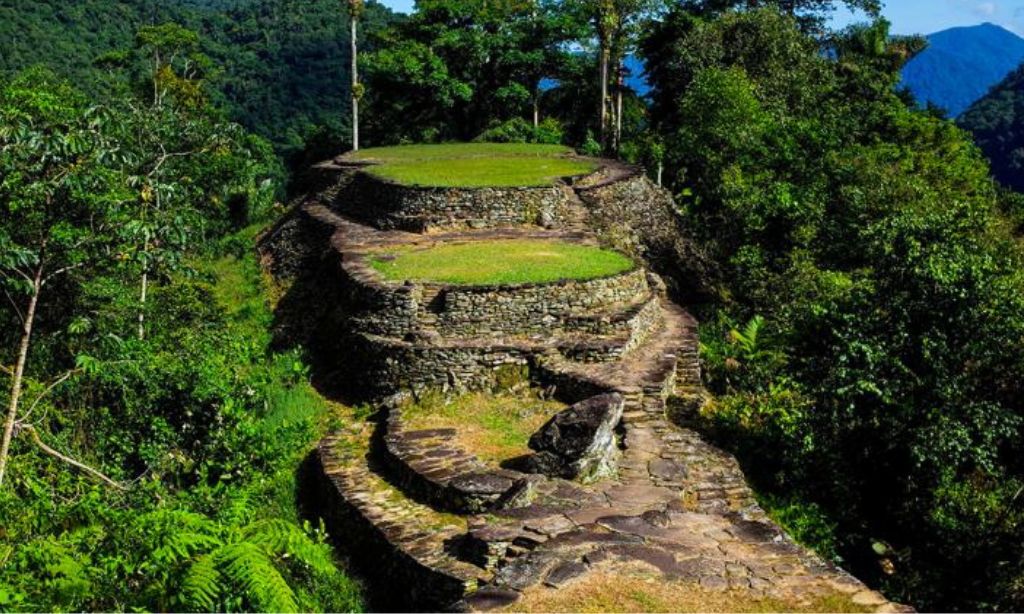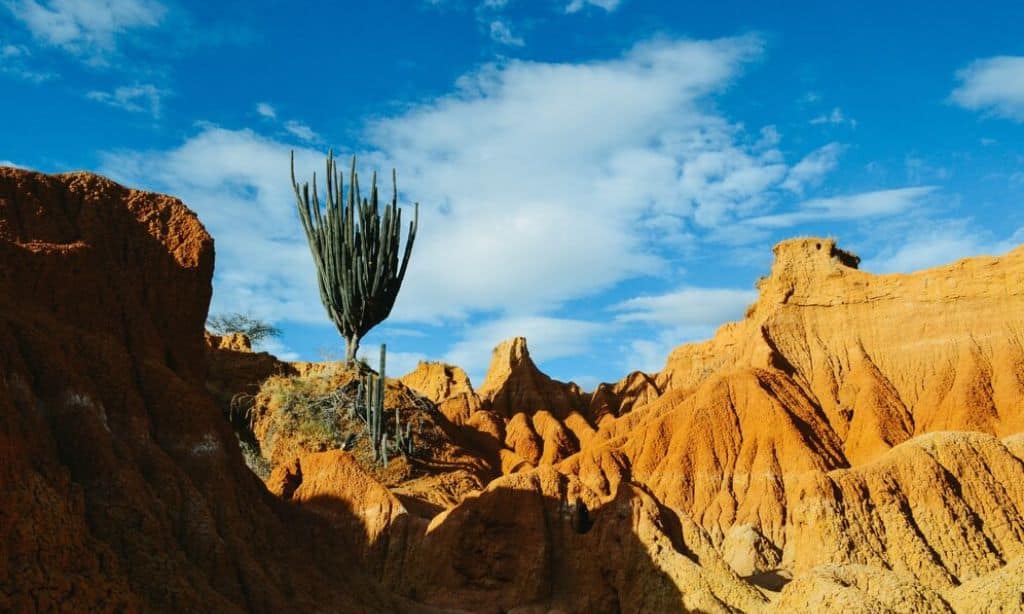Colombia is a country full of vibrant culture and natural beauty, making it a fascinating place to explore. From its lush rainforests to its bustling cities, there is so much to discover. With an array of unique facts, Colombia offers endless surprises that will captivate any traveler or curious mind.
Why is Colombia so captivating? It could be the rich biodiversity, the historical treasures, or the incredible festivals that fill the streets with color and music. You’ll find that every corner of this amazing country holds something extraordinary, making it a must-read for anyone interested in learning more about Colombia.
1. Colombian coffee is among the best in the world
When it comes to coffee, Colombia is a country that stands out. Colombian coffee is renowned for its rich, full-bodied flavor and smooth finish.
Did you know that Colombia is the third-largest coffee producer in the world? Only Brazil and Vietnam produce more. The high altitude and perfect climate conditions in Colombia contribute to the superior taste of the coffee.
The history of coffee in Colombia dates back to the late 1700s. It was introduced by Jesuits, and by the 19th century, it had become one of the country’s main exports. Today, coffee is an essential part of Colombia’s economy and culture.
Many coffee lovers prefer Colombian beans because of their balanced flavor. The country’s unique geography—with its mountains and ideal weather—creates the perfect environment for growing coffee. Colombian coffee is often described as having a mild yet rich taste with hints of citrus and chocolate.
One specific variety, Castillo, was developed to resist coffee leaf rust, a disease that affects many coffee crops. This shows the innovation and dedication of Colombian coffee farmers in producing top-notch coffee.
When you enjoy a cup of Colombian coffee, you’re not just drinking coffee; you’re experiencing a piece of Colombian tradition and expertise.
2. Bogotá is the capital city
Bogotá, the capital of Colombia, is a bustling metropolis with a population of over 7 million people. It’s the largest city in the country and serves as the political, economic, and cultural hub. Located in central Colombia, Bogotá sits at an impressive altitude of 8,660 feet above sea level.
The city was founded in 1538 by Spanish conquistadors. Its rich history is ever-present in its streets, with colonial buildings standing alongside modern skyscrapers. Bogotá’s elevation in the Andes Mountains means it enjoys a cooler climate compared to other major Colombian cities.
Bogotá covers a vast area of 613 square miles, which is roughly the same size as Greater London. Despite its size, it isn’t as densely packed as other global cities. This makes room for plenty of green spaces and parks, providing residents with places to relax and enjoy the outdoors.
The city’s diverse population reflects Colombia’s multicultural roots. People from various cultural backgrounds come together to make Bogotá a vibrant and dynamic place to live and visit. Whether you are exploring its historic sites or indulging in its culinary delights, Bogotá offers a unique experience for everyone.
3. The Amazon Rainforest covers a significant portion
Did you know that the Amazon Rainforest stretches into Colombia? This vast forest covers a large area of Colombia and accounts for a significant portion of the country’s territory.
The Amazon Basin spans across several South American countries. In Colombia, it is known as the Amazon region.
In Colombia, the Amazon Rainforest helps to maintain a rich biodiversity. It’s home to thousands of species of plants and animals. Many indigenous communities also live in the Colombian Amazon.
The Colombian Amazon is crucial for the environment. It plays a key role in regulating oxygen and carbon dioxide levels. Its trees help reduce global climate change by absorbing carbon dioxide.
Covering about one-third of Colombia’s land area, the Amazon is a natural wonder worth exploring. Its vast canopy houses countless forms of life.
Exploring the Amazon Rainforest in Colombia is an adventure. You can witness exotic wildlife, dense forests, and vibrant cultures. It’s a unique part of Colombia’s natural heritage.
4. The Andean region is stunningly diverse
The Andean region in Colombia is a marvel of nature and culture. It features a mix of vast cities, charming villages, and breathtaking landscapes. If you visit, you will see how different climates coexist here, from temperate and torrid zones to tundra and polar climates.
In addition to its climate variety, the area boasts incredible biodiversity. Many plants and animals live in the Andean region, making it one of Colombia’s most ecologically rich areas. One in every 10 species of flora and fauna can be found here.
Cultural richness is another draw. The Andean region has a blend of indigenous, European, and African influences. You will get a chance to experience various cultural traditions, festivals, foods, and dances.
Its geography is equally remarkable. Mountains, valleys, rivers, and plains characterize this region. This enables numerous outdoor activities like hiking, bird-watching, and exploring national parks.
The Andean region isn’t just about nature. It is also the heart of Colombia’s population. With over 28 million people, it is the most densely populated area in the country. Major cities like Bogotá and Medellín are located here.
Do you love history? The Andean region has a rich historical heritage too. Many colonial towns and archaeological sites can be explored.
The region’s diverse landscapes, cultures, and experiences make it a must-visit location in Colombia.
5. Colombia has more bird species than any other country
Did you know Colombia is a birdwatcher’s paradise? Colombia boasts the highest number of bird species in the world. With around 1,940 bird species, this makes up nearly 20% of all avian species on the planet. It’s an astonishing number.
The country’s diverse ecosystems play a huge part in this. From coastal regions to mountainous areas and rainforests, Colombia’s environment is perfect for birds to thrive. That’s why you can see such a variety of birds here.
Colombia is home to 78 endemic bird species. This means these species are found nowhere else on Earth. This uniqueness adds to Colombia’s charm and significance in the birdwatching community.
Migratory birds also love Colombia. About 275 migratory bird species travel through the country, connecting Colombia to the rest of the Americas. This creates an incredible opportunity to witness birds from different parts of the world.
It’s clear that Colombia’s rich bird diversity makes it a top destination for bird lovers. Whether you’re an amateur birdwatcher or an expert ornithologist, Colombia offers a truly unparalleled experience.
6. Medellín was once the murder capital; now it’s a tech hub
In the 1990s, Medellín was infamous for its high crime rates. It was known as the murder capital of the world. Much of this notoriety was due to the drug cartel led by Pablo Escobar.
Things changed in the 2000s. Medellín began to focus on innovation and technology. The city attracted international tech companies, creating many new jobs. Ruta N, a local innovation center, played a big role in this transformation.
Medellín is now home to over 379 tech and innovation companies. Companies like AI Fund and Skillshare, based in New York, have set up offices here. This shift has improved the city’s economy.
The shift from a violent past to a tech-driven future brought new opportunities for locals. The city is now a model for urban renewal, showing how technology can bring about positive change. Medellín’s story is one of hope and transformation.
7. Cumbia music originated in Colombia
Cumbia is a traditional music and dance genre that has its roots in Colombia. It began as a blend of African, Indigenous, and Spanish musical and cultural influences. These diverse elements combined to create a rhythm that is now a significant part of Colombia’s cultural heritage.
The word “Cumbia” may originate from the Bantu word “Kumba,” meaning “to roar.” This reflects the powerful and lively nature of the music. Cumbia is known for its upbeat tempo, that gets people moving.
In its traditional form, Cumbia is performed by two main types of ensembles: the conjunto de cumbia and the conjunto de gaitas. The conjunto de cumbia typically includes five instruments, while the conjunto de gaitas features two types of duct flutes, a llamador drum, and a maraca.
When danced, Cumbia is usually performed by couples. The woman often dances with shuffling steps, while the man moves in a zig-zag pattern around her. Traditionally, women also carry candles wrapped in colorful handkerchiefs.
Today, Cumbia is not only popular in Colombia but has spread across Latin America. It is especially celebrated at carnivals and cultural festivals. Cumbia music continues to evolve, blending with modern sounds while maintaining its core traditional elements. This genre remains a testament to Colombia’s rich musical history.
8. Shakira is a famous Colombian singer
Shakira, born on February 2, 1977, in Barranquilla, Colombia, is a world-renowned singer, songwriter, and dancer. Her full name is Shakira Isabel Mebarak Ripoll. She is famous for her unique voice, energetic performances, and catchy songs.
Shakira’s career took off in the early 2000s with her crossover into the English-speaking market. She gained international fame with hits like “Whenever, Wherever” and “Hips Don’t Lie.” Her music blends Latin, rock, and pop sounds, making her a versatile artist.
Apart from her musical talent, Shakira is known for her philanthropic work. She founded the Barefoot Foundation (Fundación Pies Descalzos) to support education for children in Colombia. Her efforts have helped thousands of kids get access to better schooling.
Shakira’s influence goes beyond music. She has performed at numerous global events, including the FIFA World Cup. She has also served as a Goodwill Ambassador for UNICEF since 2003, advocating for children’s rights and education.
With over 80 million records sold and numerous awards, Shakira is one of the most successful Latin American artists in history. Her bilingual skills have allowed her to break language barriers and connect with fans all around the world.
9. The National Sport is Tejo
Have you ever heard of Tejo? It’s Colombia’s national sport, and it’s quite unique. Tejo involves throwing a metal puck, known as a tejo, at a target. The target is set within a board covered in clay.
The aim is to hit small paper triangles filled with gunpowder, called mechas. When hit, these mechas explode, adding an exciting twist to the game. The sound and visuals of the explosion make the game thrilling for both players and spectators.
The standard tejo lane is about 19.5 meters long and 2.5 meters wide. Players throw their tejos from a distance of 15 meters towards the clay board. This board is inclined at around a 30-degree angle to help the tejo slide into the target.
Tejo has roots that trace back over 450 years. It was originally played by indigenous warriors. They used golden discs instead of metal pucks. Today, you can still see some of these ancient discs in museums across Colombia.
Players often enjoy the game with a beer in hand, making it a social and enjoyable activity. Tejo combines skill, precision, and a bit of luck.
10. Gabriel García Márquez, a Nobel Prize-winning author, hails from Colombia
Gabriel García Márquez, often called “Gabo,” was born on March 6, 1927, in Aracataca, Colombia. He grew up in a small town, surrounded by the vibrant culture of Colombia. His experiences would later influence much of his writing.
Gabo is best known for introducing the world to magical realism. This style blends the ordinary with the extraordinary, creating vivid, imaginative stories. His most famous work, “One Hundred Years of Solitude,” is a prime example of this.
In 1982, García Márquez won the Nobel Prize in Literature. He was the first Colombian to receive this honor. The Nobel committee praised him for his unique storytelling that combined fantasy and reality.
García Márquez’s influence extends beyond literature. His insightful writing has inspired many and brought global attention to Latin American culture. He is considered one of the greatest writers of the 20th century.
Gabo’s works are translated into many languages, making them accessible to a global audience. His stories reflect the rich, diverse culture of Colombia, leaving a lasting impact on readers worldwide.
11. Colombian Food is a Mix of Spanish and Indigenous Flavors
Colombian cuisine is a delightful blend of Spanish and Indigenous flavors. This mix creates unique and diverse dishes that reflect the country’s cultural heritage.
One popular dish is the Arepa. Indigenous people originally made this corn cake, and it remains a staple in Colombian households today.
Another favorite is Bandeja Paisa. This hearty dish includes beans, rice, pork, plantains, and avocado. The Spanish influence is seen in the use of chorizo and ground beef.
Lechona, with its slow-cooked pork, rice, and peas, shows a Spanish twist on traditional Indigenous culinary methods. It’s a beloved dish in Tolima and Bogotá.
Picada Colombiana features a variety of grilled meats and sausages. Served with potatoes, arepas, and plantains, it brings together Indigenous and Spanish flavors on one platter.
For dessert, Arroz con Leche showcases Spanish influence with its creamy rice, milk, and cinnamon.
Soups like Ajiaco combine chicken, potatoes, and corn, showing how colonial ingredients merged with Indigenous traditions.
Drinks such as Lulada use native fruits like lulo, a tangy fruit found only in Colombia.
Colombian food celebrates the country’s history, blending the best of Spanish and Indigenous cuisines. You’ll find these flavors everywhere, from street food to traditional dishes. Each bite tells a story of Colombia’s rich cultural past.
12. Cartagena is a UNESCO World Heritage site
Cartagena, located on the northern coast of Colombia, is a city rich in history and culture. In 1984, it was declared a UNESCO World Heritage site. This honor highlights its cultural and historical significance.
The city boasts well-preserved colonial architecture. You’ll find charming streets with colorful buildings and grand old churches. These structures reflect Cartagena’s past.
Cartagena’s fortifications are another highlight. The city has the largest and best-preserved fort system in South America. These forts were built to protect the city from pirate attacks and other threats.
Walking through Cartagena, you can feel its history. The historic center, known as the Walled City, is full of life. There are bustling markets, lively plazas, and beautiful views of the Caribbean Sea.
Being a UNESCO site means Cartagena receives support to preserve its heritage. This helps keep the city’s history alive for future generations. When you visit Cartagena, you are stepping into a living museum.
13. Colombia is one of the world’s largest flower exporters
Did you know that Colombia is a giant in the flower export industry? It is the second-largest flower exporter in the world, right after the Netherlands. Colombian flowers are shipped to over 90 countries, with a significant portion heading to the United States.
The flower industry in Colombia is a major job provider. It creates around 200,000 formal jobs, half of which employ women. Many of these women are head of household. This makes the flower industry crucial for supporting families across the country.
Each year, around 700 to 800 million flower stems from Colombia reach international markets. The total export value in 2022 reached $2.05 billion. Major events like Valentine’s Day drive huge demand for Colombian flowers, making this industry essential for global floral needs.
Colombia’s flowers are known for their wide variety and vibrant colors. The country’s climate and geography are perfect for growing flowers year-round. This natural advantage helps Colombian flowers maintain a strong presence in the global market.
. Juan Valdez represents Colombia’s coffee farmers
Who is Juan Valdez? Juan Valdez is a fictional character created to personify Colombia’s coffee farmers. He made his debut in 1959 in advertising campaigns. The goal was to highlight the dedication and hard work of these farmers in producing high-quality Colombian coffee.
The character of Juan Valdez, often shown with his mule, symbolizes the craftsmanship and care involved in coffee farming. The National Federation of Coffee Growers of Colombia (FNC) was the organization behind this initiative. They aimed to promote 100% Colombian coffee worldwide.
Why is Juan Valdez important? He not only represents individual farmers but also the entire Colombian coffee industry. This image helped distinguish Colombian coffee from blends containing beans from other countries. By embodying the spirit of Colombian coffee farmers, Juan Valdez boosted the global reputation of Colombian coffee.
The success of Juan Valdez has led to significant economic benefits. The brand contributed to a growth in sales for Colombian coffee over the years. Farmers benefit from this increased exposure and demand, making it a pivotal marketing triumph.
Juan Valdez’s portrayal has become iconic. It captures the essence of Colombia’s rich coffee culture and tradition. For anyone interested in coffee, Juan Valdez stands as a symbol of quality and authenticity.
15. The country boasts a variety of climates and ecosystems
Colombia is truly unique due to its variety of climates and ecosystems. You can experience everything from tropical beaches to cool mountain ranges within its borders.
In the Andes region, the climate is cooler. Here, you might find snow-capped peaks and lush highland vegetation. It’s perfect for those who enjoy hiking and exploring mountainous terrain.
The Amazon Basin in Colombia is another story. This region is hot and humid year-round, covered by dense rainforest. It’s a paradise for nature lovers, offering rich biodiversity with countless plant and animal species.
If you love beaches and warm weather, the Caribbean coast and the Pacific coast have tropical climates. You can enjoy pristine beaches, warm waters, and colorful coral reefs. It’s ideal for swimming, snorkeling, or simply relaxing by the sea.
Colombia also has vast plains called Los Llanos. These are grassy lands with a tropical savanna climate. They are great for wildlife viewing, especially during the dry season, when animals gather around the remaining water sources.
Lastly, the coastal deserts of La Guajira Peninsula offer yet another climate. The arid landscape, with unique desert flora and fauna, contrasts sharply with Colombia’s lush regions. Each region offers its own unique charm and is a treat for travelers.
16. Botero’s Art Style, ‘Boterismo’, Originated in Colombia
Fernando Botero, born in Medellín, Colombia, is famous for his unique art style called “Boterismo.” This style features exaggerated and voluminous figures of people and animals.
Botero’s work can be both humorous and critical, often reflecting his views on politics and society. The large, rounded forms are instantly recognizable and have made him a renowned artist worldwide.
Before embracing art, Botero attended a school for matadors. However, his true passion lay in painting and sculpture. He started painting while still a teenager, drawing inspiration from pre-Columbian and Spanish colonial art.
Botero’s vibrant and colorful works are not just paintings; they also include sculptures. You can find his pieces in many major cities around the world, from New York to Paris.
Though some critics argue that his style is repetitive, Botero believes in the value of exploring volume and space in his work. His art continues to influence and inspire many artists globally.
Fernando Botero’s legacy lives on, and his art style, “Boterismo,” remains a significant cultural contribution from Colombia.
17. The Sierra Nevada de Santa Marta is the world’s highest coastal range
The Sierra Nevada de Santa Marta is an isolated mountain range in northern Colombia. It stands apart from the Andes mountains and rises majestically close to the Caribbean coast. This impressive range reaches a height of 5,775 meters (18,946 feet) above sea level, making it the tallest coastal mountain range in the world.
You will find the Sierra Nevada located only 42 kilometers (26 miles) from the shores of the Caribbean Sea. Its towering peaks are a breathtaking sight, especially when considering how close they are to the coast. Few places on Earth have such dramatic elevation changes.
The Sierra Nevada de Santa Marta covers an area of approximately 17,000 square kilometers. It is home to diverse ecosystems, ranging from tropical forests at lower elevations to snowy peaks at the highest points. The variety of climates and habitats in such a condensed area makes it a hotspot for biodiversity.
In 1979, UNESCO designated the Sierra Nevada de Santa Marta as a Biosphere Reserve. This status reflects its environmental importance and the need to preserve its unique landscapes and species. Its natural beauty and ecological value attract both scientists and tourists who come to explore its rich offerings.
Whether you’re interested in geography, ecology, or simply breathtaking views, the Sierra Nevada de Santa Marta is a remarkable place. Its status as the highest coastal range in the world makes it a unique and fascinating destination in Colombia.
18. Cali is Known as the Salsa Capital
Cali, a city in southwestern Colombia, proudly wears the title “Salsa Capital of the World.” This vibrant city is where salsa dancing isn’t just an activity; it’s a way of life.
Why is Cali the salsa capital? It’s because the city hosts numerous salsa events and festivals. One of the most notable is the Feria de Cali, held every December. This festival attracts salsa enthusiasts from around the globe to dance and celebrate.
In Cali, salsa isn’t confined to dance studios. You’ll find salsa clubs everywhere. These clubs are perfect places to learn, practice, and perfect your moves. The energy is infectious, and the music never stops.
The city has even created the “Salsa Route” (La Ruta de la Salsa). This route takes you through famous salsa spots, from historic train stations to lively parks. It’s a must-see for any salsa lover visiting Cali.
Afro-Colombians and Cuban immigrants played a huge role in developing salsa culture in Cali. They brought their rich musical traditions to the city, mixing them with local Colombian rhythms. This unique blend helped shape the salsa scene in California into what it is today.
People in Cali often say, “Cali is salsa.” And it’s true. The city’s connection with salsa music and dancing is deep and enduring. Whether you’re a seasoned dancer or just starting, Cali welcomes everyone with open arms.
19. Barranquilla hosts a famous Carnival
Barranquilla, a vibrant city in Colombia, is renowned for its annual Carnival. This event is one of the largest and most celebrated in the world. You can expect a lively atmosphere filled with music, dancing, and colorful costumes.
The Carnival dates back hundreds of years. Its modern form started in the late 1800s. In 1903, the first major parade, known as the Battle of the Flowers, took place.
Held over four days, the Carnival fills every street and corner with festivities. During this time, you will see neighborhoods come alive. People of all ages participate in the celebrations.
The event attracts thousands of tourists each year. This makes it a key part of Barranquilla’s cultural identity. These days, the city is transformed into a giant party.
One remarkable aspect is the mix of African, European, and indigenous traditions. This creates a unique experience for everyone. If you’re looking to immerse yourself in Colombian culture, the Barranquilla Carnival is a must-visit.
20. Colombian emeralds are highly valued
Colombian emeralds are among the most precious gems in the world. These emeralds are known for their deep, rich green color, that stands out from other emeralds. The intensity and uniformity of the color are key factors that determine their value.
Why are they so sought-after? Colombian emeralds often have a bluish tint due to the presence of trace elements like chromium and vanadium. This unique color makes them highly desirable for jewelry.
Colombia produces 70–90% of the world’s emeralds, making it the leading source for this gem. The mines in Colombia, such as Muzo, Chivor, and Coscuez, are famous for producing high-quality emeralds.
These emeralds have a long history and cultural significance. Many royal families throughout history have cherished Colombian emeralds for their beauty. They are featured in tiaras, necklaces, and other royal jewelry.
In addition to their color, the inclusions in Colombian emeralds add to their unique charm. Unlike other gemstones, the inclusions in emeralds are often seen as part of their character. They can give the stone a unique look, making each emerald one-of-a-kind.
When buying Colombian emeralds, it’s important to consider the cut, clarity, and carat in addition to the color. A well-cut emerald with fewer inclusions and a vibrant color can be incredibly valuable.
Would you like to own a piece of history and beauty? Colombian emeralds offer a perfect blend of natural wonder and luxury.
21. The Lost City, Ciudad Perdida, is Older Than Machu Picchu
Ciudad Perdida, also known as the Lost City, is an archaeological site in Colombia. It was founded around 800 CE, which means it’s about 650 years older than Machu Picchu in Peru.
You can find Ciudad Perdida in the Sierra Nevada de Santa Marta region. The closest major city is Santa Marta.
The Tairona people built this city. They were highly skilled and resourceful builders who demonstrated advanced techniques for their time.
Intriguingly, only a small part of Ciudad Perdida has been excavated. Imagine what other secrets this ancient city might hold!
So, if you visit Colombia, consider exploring Ciudad Perdida. You’re not only seeing ruins but also a piece of history that predates even the most famous ancient sites.
Did you know the name “Ciudad Perdida” translates to “Lost City”? It remained hidden for centuries, adding to its mysterious allure.
Explorers discovered it in the 1970s. Since then, it has fascinated archaeologists and travelers alike.
22. There are over 90 ethnic groups in Colombia
Did you know that Colombia is a country rich in ethnic diversity? There are more than 90 ethnic groups across the nation. This fascinating mix includes Afro-Colombians, indigenous peoples, and Romani populations.
Afro-Colombians make up a significant part of the population. They mainly live in coastal regions and speak different languages, such as the San-Andres-Providencia Creole.
Indigenous groups in Colombia have their own distinct languages and cultures. Each group maintains its own unique traditions and ways of life.
The Romani population, though smaller, also adds to the diverse tapestry of ethnicities in Colombia.
With over 90 ethnic groups, Colombia’s diversity is one of its most captivating features.
23. Football is extremely popular
Football, also known as soccer, is a huge part of Colombian culture. You can see people playing it everywhere—on the streets, in parks, and in schools. It’s a game that brings families and friends together.
Many Colombian players are famous worldwide. Some of them play for top European clubs like Real Madrid, Arsenal, and A.C. Milan. This international presence makes Colombians very proud.
Colombian football fans are very passionate. They wear their team’s colors, often the iconic yellow jersey, with great pride. The excitement is palpable during matches, especially when the national team plays.
James Rodriguez, a standout player, is a household name in Colombia. His skill and dedication make him a role model for many young athletes in the country. The national team’s success in tournaments is celebrated widely.
Football isn’t just a sport in Colombia; it’s a way of life. It allows people of all ages and backgrounds to connect. The game’s accessibility ensures that everyone, regardless of their social status, can join in.
In summary, football’s popularity in Colombia is immense. It’s woven into the fabric of daily life and culture, touching the hearts of millions.
24. Colombia has hosted the Pan American Games
Did you know that Colombia has had the honor of hosting the Pan American Games? The city of Cali, located in the Valle del Cauca region, was chosen as the host in 1971. This event marked a significant milestone for Colombia in international sports.
Hosting the Pan American Games brought global attention to Colombia’s athletic talent and infrastructure. The games included a variety of sports, showcasing the diversity and skill of athletes from across the Americas.
Cali’s successful hosting of the event also had lasting effects on the city and the region. It spurred the development of sports facilities and motivated a generation of athletes. Many of these upgraded facilities continue to be used for national and international competitions.
The choice of Cali as the host city underscored its reputation as a sports hub. The city has continued to build on this legacy by hosting other major sporting events, such as the World Games in 2013 and the Pacific Games in 2005.
Colombia’s continued participation and success in international sports can trace some roots back to hosting this prestigious event. The experience and exposure gained from hosting the Pan American Games have undeniably contributed to Colombia’s sporting achievements.
25. El Dorado Legend Originated in Colombia
The legend of El Dorado began with the Muisca people of Colombia. The Muisca lived in the Andes region, in the areas now known as Cundinamarca and Boyaca.
El Dorado means “The Golden One.” It referred to the Muisca king, who was said to cover himself in gold dust. This king would then dive into Lake Guatavita as part of a ritual.
The Spanish Empire first heard of El Dorado in the 16th century. Conquistadors, like Sir Walter Raleigh, were lured by tales of immense wealth.
Many expeditions searched for the golden city. Explorers hoped to find treasures and riches beyond belief. They believed El Dorado was an entire city or region filled with gold.
El Dorado’s legend grew over time. It wasn’t just about a person or a ritual anymore. It became a symbol of vast, hidden wealth.
Even though no city of gold was ever found, the story endures. It lives on in popular culture and history, forever tied to Colombia.
26. The Country Has Five Main Regions: Andean, Caribbean, Pacific, Orinoco, and Amazon
Colombia is a country of diverse landscapes and cultures. It is divided into five main regions. Each region has unique features.
The Andean region is known for its mountains. It includes the Andes mountain range. Many of Colombia’s largest cities, like Bogotá and Medellín, are found here.
The Caribbean region borders the Caribbean Sea. It is famous for its coastal beaches and vibrant culture. The city of Cartagena is a popular tourist destination in this region.
The Pacific region is along the Pacific Ocean. This area is rich in biodiversity. It includes rainforests and stunning coastlines. It’s less populated but offers a glimpse of pristine nature.
The Orinoco region, also called Orinoquía, consists of vast plains known as Llanos. It is shared with Venezuela. The region is great for cattle ranching and has unique wildlife.
The Amazon region contains part of the Amazon Rainforest. This area is full of dense jungles and exotic species. It shares its rainforest with Brazil, Peru, and other countries.
These regions make Colombia a fascinating country with natural beauty and cultural richness. Traveling through these areas shows the country’s varied landscapes and lifestyles.
27. The Magdalena River is the primary river
The Magdalena River, or Río Magdalena, stretches over 1,528 kilometers (about 949 miles) through Colombia. It’s the longest river in the country.
This river begins its journey in the Andes Mountains and flows northward. Its path covers a large part of the country, influencing many regions.
The river is crucial for transportation. It allows the movement of goods like agricultural products and minerals. Barges and riverboats frequently navigate its waters.
The Magdalena River also has a rich historical significance. It has played a key role since colonial times, connecting various cities and communities.
Wildlife thrives along the river. You can find diverse species of birds, fish, and other animals.
The name “Magdalena” comes from the biblical figure Mary Magdalene. This highlights its cultural importance.
For locals and visitors, the river is a stunning natural attraction. It is a part of Colombia’s geographic and cultural fabric.
Through its majestic flow, the Magdalena River stands as Colombia’s lifeline.
28. Spanish is the Official Language
Did you know that Spanish is the official language of Colombia? Almost the entire population speaks Spanish. It’s the language used in government, education, and media.
Colombia is one of the largest Spanish-speaking countries in the world. About 99% of Colombians use it as their primary language. This makes it easy for travelers who speak Spanish to communicate.
The richness of Colombian Spanish includes regional accents and slang. Each region has its own unique way of speaking Spanish. This diversity adds to the country’s rich cultural tapestry.
Knowing Spanish in Colombia is essential for daily life. From ordering food to making friends, you’ll find it handy everywhere you go. So, brush up on your Spanish before visiting!
29. The peso is the currency used
Did you know that the peso is the official currency of Colombia? It’s represented with the symbol $ but is often shown as COP to avoid confusion with other currencies.
The Colombian peso is divided into 100 smaller units, called centavos. Although centavo coins were used in the past, they stopped being issued since 1984 due to high inflation.
Colombian pesos come in various denominations. Coins include 50, 100, 200, 500, and 1,000 pesos. Banknotes are available in 1,000, 2,000, 5,000, 10,000, 20,000, and 50,000 pesos.
The peso has undergone several changes over time. For a while, you could even exchange pesos for gold until this practice ended in 1931.
Modern peso notes are colorful and feature important figures from Colombia’s history. You will find these notes used across the country, from big cities to small villages.
In daily life, you might need smaller coins for bus fares or small purchases. Larger bills can be used in supermarkets and bigger stores. As a traveler, it’s handy to carry a mix of both.
30. Colombian food includes arepas, empanadas, and bandeja paisa
Colombian food is rich and diverse. A popular favorite is arepas. These flatbreads made from corn are a staple in Colombian cuisine. You can eat them plain or with cheese, butter, or avocado. Arepas are enjoyed at any time of the day.
Empanadas are another beloved Colombian dish. These are pastries filled with meat, cheese, or vegetables. Empanadas are usually fried and served with a spicy sauce called “ají”. They make for a delicious snack or meal.
Bandeja paisa is a hearty platter from the Antioquia region. This dish includes beans, powdered beef, chicharrón (fried pork belly), rice, plantains, chorizo, and a fried egg. It’s a complete and filling meal, often served on a large tray or platter.
These dishes showcase the flavor and variety of Colombian cuisine. They reflect the country’s love for simple yet hearty meals. Enjoying these dishes is a great way to experience the culture and traditions of Colombia.
Whether you’re in Colombia or trying these recipes at home, you’re in for a treat.
31. El Cocuy Natural Park Offers Stunning Glaciers and Snow Peaks
El Cocuy National Park is one of Colombia’s hidden gems. It features impressive glaciers and majestic snow-capped peaks. This park is located in the Andes mountain range.
With 18 snow-covered mountains, the park offers a breathtaking landscape. You can witness towering ice formations and crystal-clear glacial lakes.
For adventure seekers, the park is a paradise. Hiking trails lead you through stunning scenery. Be prepared for chilly temperatures, which can drop to -20°C at higher altitudes.
El Cocuy covers about 3,060 square kilometers. It is managed by SINAP, under the Ministry of Environment.
This park is a fantastic spot for anyone interested in nature and photography. The lush cloud forests and unique páramo regions add to its diverse beauty.
Be aware of the rainy seasons, from January to March and May to June. These can affect your hiking plans.
32. Guatapé is known for its colorful houses and El Peñol rock
Guatapé is a vibrant town in Antioquia, Colombia. It’s famous for its brightly colored houses, which draw tourists from all over the world. Each house is adorned with unique zócalos, which are decorative panels that tell stories or feature beautiful designs.
One of the main attractions in Guatapé is El Peñol rock. This giant granite rock offers breathtaking views of the surrounding area. It takes 740 steps to reach the top, but the stunning panorama is worth every step.
The rock is also known as La Piedra or The Stone of El Penol. It’s an important landmark for both for locals and visitors. Near the rock, you can enjoy a relaxing boat ride on the man-made reservoir.
Visiting Guatapé offers a mix of colorful streets, cultural experiences, and natural beauty. The combination of the lively town and the impressive rock makes it a must-visit destination in Colombia.
33. Caño Cristales is known as the ‘River of Five Colors’
Caño Cristales, located in Colombia’s Serranía de la Macarena national park, is often called the “River of Five Colors.” This breathtaking river is famous for its vivid, changing colors. These colors appear due to a unique aquatic plant called Macarenia clavigera.
From July to November, the plants bloom in shades of red, pink, green, yellow, and blue. This creates a stunning, rainbow-like effect in the water. Outside this period, the river looks like any ordinary river.
The river stretches approximately 62 miles long. It’s a tributary of the Guayabero River, part of the larger Orinoco basin. Discovered in 1969, Caño Cristales remains one of Colombia’s natural wonders. It draws visitors from around the world, all eager to witness its beauty.
34. Tayrona National Natural Park is a must-visit destination
Located on Colombia’s northern Caribbean coast, Tayrona National Natural Park is famous for its stunning landscapes. The park is home to beautiful beaches, lush jungles, and a variety of wildlife.
The entrance fee varies, with foreigners paying around 57,500 COP ($12 USD) during normal seasons. The fee increases to 68,000 COP ($14 USD) in high season. high season typically includes mid-December to mid-January and holidays.
Visiting during February and March is ideal. The weather is dry, and the crowds are smaller. The park offers great hiking opportunities with scenic trails that lead to Cabo San Juan Beach.
Wildlife enthusiasts will be excited. Tayrona is a biodiversity hotspot. You can see monkeys, exotic birds, and unique plant species. The Sierra Nevada de Santa Marta mountains provide a stunning backdrop.
Tayrona National Natural Park was established in 1964. Its purpose was to protect these natural wonders. The park covers a wide range of habitats, making it a key area for ecological conservation. The combination of coastal and mountain landscapes makes it unique.
The park’s mix of pristine beaches, rainforests, and wildlife is hard to match. It’s a place where nature lovers and adventurers feel at home. Don’t miss it.
35. Canoeing in the Amazon River is popular among tourists
Canoeing in the Amazon River offers an unforgettable experience for adventure seekers. You can explore the rich biodiversity of the Amazon rainforest in an up-close and personal way.
Tourists often choose kayaking and canoeing because it allow them to move quietly through the water. This helps in spotting various wildlife, such as monkeys, toucans, and pink river dolphins.
Many tours are available, ranging from single-day trips to multi-day adventures. You can choose budget-friendly options or more luxurious packages. Some tours offer extra activities, like guided hikes through the rainforest.
Participating in these tours not only provides adventure but also supports local tourism. You help local guides and communities by choosing these excursions.
Canoeing trips also often include educational components. Guides provide insights about the plants and animals you encounter. This makes the experience both fun and informative.
Would you like to see giant water lilies or hunt for caimans at night? Canoeing tours might offer you these unique opportunities, making your trip even more memorable.
With options for all budgets and various durations, canoeing in the Amazon River has something for everyone. You can tailor your adventure to fit your schedule and interests.
36. Colombia is the second-most Most Biodiverse Country in the World
Did you know you’d find over 51,000 species in Colombia? The country is a treasure trove of life. You’ll see more bird species here than in all of North America and Europe combined.
Colombia is second only to Brazil in terms of overall biodiversity. Yet, it’s much smaller in size. It has a high density of species per square kilometer.
The variety is incredible. You could spot more than 1,920 bird species and over 1,500 types of fish. Colombia also has a significant number of mammals and endemic species that are unique to the country.
If you’re interested in plants, Colombia is a paradise. It leads the world in the number of orchids. The diverse ecosystems range from the Amazon rainforest to Andean mountains and coastal regions.
Why is Colombia so biodiverse? Its location near the equator, varied climate, and different altitudes create perfect conditions. You’ll find rainforests, mountains, deserts, and coasts all in one place.
Whether you’re walking through a forest or diving in the ocean, Colombia always has something new. So next time you think about biodiversity, remember this gem in South America.
37. It has a growing economy
Colombia’s economy has shown significant growth in recent years. As one of the largest economies in Latin America, it continues to attract investments. Recent data indicates that its economy expanded by 0.6% in 2023. This growth, though modest, sets a positive trend for future expansion.
You might wonder what drives this growth. Colombia’s economy benefits from various sectors. Coffee, oil, and coal are key exports. High prices for these commodities have boosted the economy. The country also has a strong agriculture sector and is a leading flower exporter.
Moreover, the consumption boom plays a big role. Increased consumer spending has helped fuel economic activities. Efforts to improve infrastructure and business environment also contribute to economic expansion.
Colombia is classified as an upper-middle-income economy. This status reflects its growing economic stability and potential. You will find that the government continues to implement policies aimed at sustaining this growth. As a result, the future looks promising for Colombia’s economic development.
38. San Andrés and Providencia are beautiful Caribbean islands
San Andrés and Providencia are stunning Caribbean islands that belong to Colombia. They are about 775 kilometers northwest of mainland Colombia. These islands boast some of the most pristine beaches in the world.
The waters around San Andrés and Providencia are often referred to as the “Sea of Seven Colors.” This is due to the varying shades of blue and green in the ocean. The vibrant marine life makes them a popular destination for diving and snorkeling.
You can find almost forty scuba diving sites around these islands. Some of the best beaches in the Caribbean are located here, offering soft white sand and clear waters. The hospitality of the local people adds to the charm of these islands.
San Andrés is the largest island in the archipelago and serves as the capital. Providencia and Santa Catalina are smaller but equally beautiful. The islands are a UNESCO Biosphere Reserve, highlighting their ecological and cultural importance.
Whether you want to relax on the beach or explore underwater, San Andrés and Providencia offer a perfect escape. The mix of natural beauty and rich culture makes these islands a must-visit destination.
39. Parque Jaime Duque is a popular family attraction
Parque Jaime Duque is a must-visit spot for families in Colombia. Just 30 minutes from Bogotá, it is both fun and educational.
The park features a range of attractions. You can find museums, a zoo, and replicas of famous landmarks. There are also amusement rides and ecological trails.
Kids of all ages enjoy the children’s rides. Adults can relax at one of the many restaurants. The monorail makes it easy to explore every part of the park.
One special feature is the Monument to the Nationality. It represents Colombia’s rich cultural heritage. Another highlight is the Museum of Mankind, which showcases human history.
The park belongs to the Jaime Duque Foundation. Profits go to charity, making it a visit you can feel good about.
Rain or shine, there’s always something to do. Some attractions may close for weather, but there’s plenty to enjoy year-round. Whether you’re a local or a tourist, Parque Jaime Duque offers something for everyone.
40. Colombia’s Independence Day is celebrated on July 20
Colombia’s Independence Day is an important holiday. It is celebrated every year on July 20. This day marks the beginning of Colombia’s journey to independence from Spain.
On July 20, 1810, the residents of Bogotá protested against Spanish rule. These protests were a significant step towards independence. The Viceroy, a Spanish official, was pressured to accept limited independence.
This event served as a catalyst for independence movements across Latin America. Many other countries in the region were inspired by Colombia’s actions.
Today, Colombians celebrate this day with parades, music, and fireworks. It is a day of national pride and remembrance. People gather to honor their history and heroes of independence.
The celebration of July 20 is not just limited to Colombia. Colombian communities around the world also participate. This makes the holiday a global event.
You will often see the Colombian flag displayed proudly on this day. It symbolizes the country’s freedom and unity.
Understanding Colombia’s struggle for independence helps appreciate the significance of this day. The celebrations remind us of the country’s rich history and culture.
41. Barichara is often called the prettiest town in Colombia
Have you ever wondered which town is considered the prettiest in Colombia? Many say it’s Barichara. This small colonial town is located in the Santander department.
Barichara is known for its white colonial buildings. These buildings have colorful accents and are often adorned with flowers and plants. The cobblestone streets add to its timeless charm.
The town’s architecture dates back to the Spanish conquest. It is a National Monument because of its perfectly preserved buildings. The red-tiled roofs and cobbled streets enhance its rustic beauty.
Barichara is not just about looks. It’s also a great place for visitors. There are small stores, ATMs, and even tuk-tuk mototaxis for easy transport. The town is hilly, so bring comfortable walking shoes.
If you love history, Barichara will not disappoint. You can walk through the town and almost feel like you have traveled back in time. The scenic backdrop and well-maintained structures make it a photographer’s paradise.
In addition to its visual appeal, Barichara offers practical conveniences. This makes it an enjoyable and accessible destination. Whether you are exploring Colombia or planning a specific trip, Barichara is worth a visit.
42. Tatacoa Desert is a Major Astronomical Observation Site
The Tatacoa Desert in Colombia is not a traditional sandy desert but a dry tropical forest. Its unique topography includes red and grey sand formations, akin to Martian landscapes. This makes it a visually striking location.
One of the desert’s major attractions is its ideal conditions for stargazing. The arid climate means clear skies with hardly any clouds. Additionally, the area has minimal light pollution, making the stars highly visible.
The desert is home to an astronomical observatory. This observatory boasts several powerful telescopes. These telescopes offer an incredible view of the night sky. You can see planets, stars, and even distant galaxies.
Tourists flock to the desert to experience these night skies. Stargazing tours are a popular activity. They provide detailed information about the astronomical features visible from the desert.
Tatacoa’s stargazing opportunities are among the best in South America. Whether you’re an amateur astronomer or just love gazing at the stars, this desert offers a memorable experience.
Would you like to see the Milky Way with your own eyes? Tatacoa Desert is one of the few places where this is possible. Don’t miss out on this unique experience.
43. Santa Marta is the Oldest Surviving City in Colombia
Did you know that Santa Marta is the oldest surviving city in Colombia? Founded in 1525 by Spanish conquistador Rodrigo de Bastidas, it has a rich history spanning nearly 500 years. This makes it the oldest permanent settlement in the country.
Santa Marta is named after Saint Martha, the patron saint of homemakers and hoteliers. The city honors her with many festivals and celebrations throughout the year. This connection to its namesake adds a unique cultural layer to the city.
The architecture in Santa Marta reflects its long history. You can see colonial-era buildings mixed with modern structures. Walking through the historic center, you will find old churches, vibrant plazas, and charming cafes.
Tourism plays a big role in Santa Marta’s economy today. Visitors flock to the city for its beautiful beaches and nearby natural attractions. The clear, warm weather, especially from January to March and June to August, makes it an ideal travel destination.
Santa Marta is not just about history and scenic beauty. It’s also an entry point to the Tayrona National Natural Park and the “Lost City” trek. These places offer amazing outdoor experiences for adventure seekers.
Santa Marta’s blend of historic charm, natural beauty, and cultural significance makes it a standout destination in Colombia.
44. The traditional hats are called ‘sombrero vueltiao’
Have you ever seen the iconic sombrero vueltiao? It’s a traditional hat from Colombia that stands out due to its unique design. This hat is crafted from Gynerium sagittatum, a type of cane known locally as caña flecha.
The name “vueltiao” comes from the Spanish word for “turn.” This is because of the way the cane strips are meticulously woven together. Each hat is a display of intricate craftsmanship.
Did you know that the sombrero vueltiao is more than just a fashion accessory? It’s a national symbol. In 2004, the Colombian government declared it as such, recognizing its cultural significance.
The hat’s design includes bold black and white patterns. These patterns are not just decorative; they often hold cultural meanings and tell stories of the region’s heritage. You’ll see people wearing these hats all over Colombia, especially in the northern Caribbean region.
The process of making a sombrero vueltiao is labor-intensive. The leaves of the cane are dried under the sun for several days to achieve the right color and texture. Each hat can take weeks or even months to complete, depending on its complexity.
When you travel to Colombia, keep an eye out for these amazing hats. They are sold in shops, markets, and by street vendors. Owning a sombrero vueltiao is like owning a piece of Colombian culture.
45. Petroglyphs can be found in San Agustín Archaeological Park
San Agustín Archaeological Park is a treasure trove of ancient art and culture. One of the highlights is its numerous petroglyphs. These carvings on rock surfaces are a great example of the artistic skills of the San Agustín people.
You’ll find petroglyphs throughout the park, often near statues and tombs. They feature intricate designs and figures, offering a glimpse into the beliefs and daily life of the ancient civilization.
Many of the petroglyphs depict animals, geometric shapes, and human figures. These images hint at the importance of nature and mythology. The carvings are believed to have had spiritual or ceremonial significance.
The park is one of Colombia’s most important archaeological sites and has been declared a UNESCO World Heritage Site. Its rich history makes it a must-visit destination. When you explore the park, you’ll see these ancient carvings up close, giving a deeper connection to Colombia’s past.
This site not only showcases statues but also these artistic carvings that have endured for centuries. It’s a remarkable experience for history buffs and casual visitors alike.
46. The Muisca people created intricate gold artifacts
The Muisca people, one of the indigenous groups in ancient Colombia, were experts in gold craftsmanship. They lived in the region that includes today’s Bogotá between 600 and 1600 CE. Their territory was rich in natural resources, and they used gold to make various objects.
Muisca gold artifacts are known for their detailed and elaborate designs. These pieces include jewelry, ornaments, and religious items. Their goldwork is considered some of the finest in the ancient Americas.
You can see many of these gold pieces at the Gold Museum in Bogotá. One famous artifact is the Muisca Raft, which shows a scene of a ceremonial ritual. This piece highlights the importance of gold in Muisca culture.
Gold was not merely decorative for the Muisca; it had significant political and religious meanings. The Muisca believed that gold had spiritual properties and used it in ceremonies to honor their gods.
By studying Muisca gold artifacts, you gain insight into their advanced techniques and rich cultural heritage. The precision and beauty of their work continue to impress historians and visitors alike.
47. Chocó Department is Rich in Cultural and Biological Diversity
Chocó Department is located in the western part of Colombia. It has coastlines on both the Pacific Ocean and the Atlantic Ocean. This makes it the only Colombian department with such a feature.
You will find one of the largest Afro-Colombian communities in Chocó. The region also has a significant Amerindian population. This blend of cultures makes visiting Chocó a unique experience.
Natural beauty is abundant in Chocó. Dense rainforests cover large parts of the region. These forests are home to diverse wildlife, including many rare species.
The Pacific coast of Chocó boasts deserted beaches and rich biodiversity. Here, you can witness some of the world’s rarest creatures. Utria National Park is a must-visit for nature lovers.
The warm and welcoming local community loves to share its culture. Traditional music and dance are a big part of life here. Food in Chocó is also a highlight, with fresh seafood and unique local dishes such as coconut rice and fried bananas.
Due to its natural and cultural diversity, Chocó remains an untouched treasure. It offers a genuine taste of Colombia’s heritage and natural wonders.
48. Colombia’s fashion industry is growing rapidly
Colombia’s fashion industry is making waves on the global stage. Major cities like Bogota, Medellin, and Cali are at the heart of this transformation. These cities are known for their skilled workforce and innovative designs.
The industry represents a significant part of the country’s economy. Fashion contributes about 9.4% of Colombia’s GDP. This sector employs around 600,000 people across the nation.
Colombian fashion includes a wide range of high-quality products. More than 1,200 Colombian brands export their garments to over 100 countries worldwide.
The sector has shown impressive growth in recent years. It was expected to reach a market size of 30 billion COP pesos by the end of 2022.
Colombian designers are gaining international recognition. They showcase their work at major events like MAGIC in the United States, setting trends with sustainable and innovative designs.
The history of Colombian fashion is also rich and varied. From traditional garments to modern, cutting-edge designs, the industry reflects the country’s diverse culture and heritage.
You can see this vibrant industry at key fashion events held throughout the year. These events attract buyers, designers, and fashion enthusiasts from around the world.
49. Zipaquirá Salt Cathedral is an underground marvel
The Zipaquirá Salt Cathedral is an incredible underground church in Zipaquirá, a small town near Bogotá, Colombia. This cathedral was carved within the tunnels of an old salt mine. It’s 200 meters (660 feet) underground, inside a halite mountain.
It’s not just a place of worship; it’s a marvel of architecture and art. The tunnels leading to the church feel like stepping into another world. Made entirely of salt, it’s a unique and stunning sight.
Inside, there are three main areas, symbolizing different sections of a traditional cathedral. The craftsmanship here is amazing. Thousands of tons of salt were used to carve beautiful altars, crosses, and statues throughout the church.
This underground cathedral is a popular tourist destination. People from all over the world come to see its beauty and feel its spiritual significance. The mix of natural salt formations and human-made sculptures makes it a special experience.
The cathedral also serves as a pilgrimage site. Many Colombians visit to reflect and pray. The serene environment inside offers a peaceful retreat from the outside world.
Visiting the Salt Cathedral of Zipaquirá is a must if you find yourself in Colombia. It’s a place where history, culture, and natural beauty come together in a unique way.
50. Mompox is a picturesque colonial town
Have you ever wondered what it’s like to visit a town frozen in time? Mompox, also known as Santa Cruz de Mompox, is just that. Located about 125 miles south of Cartagena, Mompox stands out with its beautifully preserved colonial architecture.
In Mompox, you can stroll through narrow streets lined with historic buildings that date back to Spanish colonial rule. The town’s churches and houses look much as they did centuries ago.
Gabriel García Márquez, the famous Colombian writer, was fond of Mompox. This town takes you back to the past, offering a unique experience far from modern hustle and bustle.
A visit to Iglesia Santa Barbara is a must. Climb the church’s tower for a stunning view of the town. For just a few Colombian Pesos, you can see Mompox from an incredible vantage point.
Mompox’s charm isn’t limited to its buildings. The local markets are full of handmade crafts, jewelry, and clothing. You can find unique items to remember your visit.
Mompox is also a UNESCO World Heritage site. This recognition highlights its cultural and historical significance. It’s not just a town; it’s a living museum with stories waiting to be discovered.
Geographical Diversity
Colombia’s geographical diversity is one of its most striking features. The country offers a unique mix of lush rainforests, towering mountain ranges, and scenic coastlines, each with its own distinct characteristics and significance.
Andean Region
The Andean Region of Colombia is home to the Andes mountains, which stretch across the country. This area is known for its breathtaking landscapes, diverse climate zones, and vibrant culture.
The capital city, Bogotá, is located here at an altitude of 2,640 meters (8,660 feet). The Andean Region is also famous for its coffee plantations. The world-renowned Coffee Triangle is situated in this region, where you can see endless coffee farms and taste some of the finest coffee.
Another significant feature is the páramos, high-altitude ecosystems unique to this region. The páramos are vital for water regulation and support unique flora and fauna. Major cities like Medellín and Cali are also part of the Andean Region, contributing to its importance economically and culturally.
Amazon Rainforest
Colombia’s Amazon Rainforest is part of the larger Amazon Basin and is a biodiversity hotspot. This region makes up approximately one-third of Colombia’s territory and is one of the most ecologically diverse areas in the world.
The Amazon Rainforest is home to thousands of species of plants, animals, and insects. Communities of indigenous people also live in this region, maintaining their traditional ways of life. The rainforest plays a crucial role in global oxygen production and carbon dioxide absorption.
The Amazon River, flowing through this region, provides habitats for pink river dolphins, piranhas, and countless other aquatic species. Adventures such as treks, river tours, and wildlife spotting are popular activities for those visiting this remarkable part of Colombia.
Caribbean Coastline
Colombia’s Caribbean Coastline is a geographical marvel with its crystal-clear waters, sandy beaches, and rich cultural heritage. This region spans from the Gulf of Urabá to the Guajira Peninsula.
Famous destinations like Cartagena and Santa Marta boast beautiful colonial architecture and vibrant local markets. The Sierra Nevada de Santa Marta, the world’s highest coastal mountain range, rises dramatically from the sea here. This area also hosts the Tayrona National Natural Park, a haven for nature lovers and adventure seekers.
The region’s warm climate and inviting beaches make it a popular destination for tourists. Activities like snorkeling, diving, and exploring the Rosario Islands highlight the natural beauty of Colombia’s Caribbean Coastline.
Cultural Richness
Colombia boasts a vibrant and diverse cultural landscape, deeply rooted in its history and traditions. From its rich musical heritage to its colorful festivals and diverse indigenous communities, Colombia offers an incredible cultural experience.
Music and Dance Traditions
Colombian music and dance are central to the country’s cultural life. Cumbia and vallenato are two iconic genres that originated here. Cumbia blends African, Indigenous, and Spanish influences, often featuring drums, flutes, and vibrant dance.
Vallenato, on the other hand, uses accordions, guitars, and percussion to tell stories of everyday life. Salsa and reggaeton are also very popular, especially in cities like Cali. Music and dance are not just for entertainment; they are integral to Colombian identity and community life.
Indigenous Communities
Colombia is home to around 100 indigenous nations, each with its own unique traditions and languages. These communities play a significant role in preserving Colombia’s rich cultural heritage. The Wayuu, located in the northern deserts, are known for their intricate weaving and vibrant crafts.
In the Amazon, the Ticuna people maintain their distinct customs and languages. These communities often live in biodiversity-rich regions, and their traditional knowledge contributes significantly to environmental conservation. Indigenous markets and festivals offer a window into their rich, diverse cultures.
Colombian Festivals
Colombian festivals are renowned for their exuberance and color. The Carnival of Barranquilla, held before Lent, is one of the biggest festivals in the country, featuring parades, music, and dance. It’s a time when the entire city comes alive with costumes and celebrations.
The Festival of the Flowers in Medellin is another major event, showcasing the region’s stunning floral displays. Bogotá celebrates the Ibero-American Theater Festival, which attracts performers from all over the world. These festivals are important for cultural expression and community bonding, reflecting the joy and creativity of the Colombian people.
Historical Milestones
Colombia’s history is a rich tapestry of ancient civilizations, colonial influence, a struggle for independence, and significant modern developments that have shaped the country today.
Colonial History
Before the arrival of the Spanish, Colombia was home to various indigenous groups, including the Muisca, known for advanced culture and metalworking. The Spanish arrived in 1499 and soon began to conquer the region.
In 1538, Spanish explorer Gonzalo Jiménez de Quesada founded the city of Bogotá. Spanish rule led to the establishment of the Viceroyalty of New Granada in 1717, which included Colombia, Ecuador, Panama, and Venezuela. European colonization profoundly impacted local culture, language, and religion.
Independence Movement
The struggle for independence began in the early 19th century. On July 20, 1810, Colombians initiated their fight against Spanish rule, marked by the Llorente Flower Vase incident. This event is now celebrated as Colombian Independence Day.
Simón Bolívar, a key figure in Latin American independence, helped lead the fight. By 1821, Bolívar’s forces had defeated the Spanish, resulting in the independence of Colombia. The Republic of Gran Colombia was established, although it later split into separate countries. Independence movements across Latin America were significantly influenced by Colombia’s success.
Modern Developments
Colombia has faced numerous challenges, from political unrest to internal conflicts. In 1948, the assassination of popular leader Jorge Eliécer Gaitán led to a period of violence known as “La Violencia.”
Recently, the country made significant strides towards peace. In 2016, the government signed a peace agreement with the FARC, a major guerrilla group, ending a 50-year conflict. This was a landmark moment for Colombia, opening the door for further development and stability.
Economic growth has been notable, with sectors like tourism and coffee production playing crucial roles. Today, Colombia continues to progress while honoring its complex and diverse history.
Takeaways
Colombia is a country rich in culture, biodiversity, and history. From the stunning landscapes to the vibrant cities, there is something for everyone to appreciate.
Did you know that Colombia has the highest diversity of bird species in the world? This makes it a paradise for birdwatchers.
Colombia’s culture is also deeply rooted in music and dance. You might find yourself tapping your feet to the rhythm of cumbia or vallenato.
If you are a coffee lover, you will be fascinated by Colombia’s world-renowned coffee regions. The country’s coffee is considered some of the best globally.
The diverse geography of Colombia includes mountains, rainforests, deserts, and savannahs. Each region offers unique wildlife and plant species.
Colombians are passionate about soccer. The national team and players are celebrated with great enthusiasm and pride.
Exploring Colombia’s ancient history, you will come across remarkable sites like the Lost City, which predates Machu Picchu by over 600 years.
Visiting Colombia allows you to experience a blend of traditional and modern influences. The country has undergone significant changes, making it a more peaceful destination.
Colombia is a place where you can enjoy delicious cuisine, friendly locals, and memories that will last a lifetime. Whether you are exploring the Amazon or the bustling streets of Bogotá, you are in for a treat.
Don’t miss out on the beautiful beaches, historical landmarks, and warmth of Colombian hospitality. Every corner of this country has its own story to tell.











































